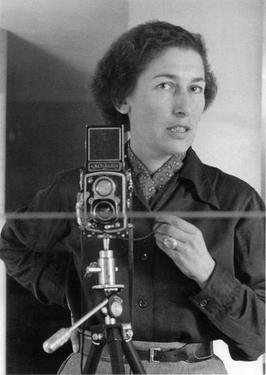
Gisèle Freund
Gisèle Freund (born Gisela Freund; 19 December 1908[1] in Schöneberg (Berlin) – 31 March 2000[1] in Paris) was a German-born French photographer and photojournalist, famous for her documentary photography and portraits of writers and artists.[2][3][4][5] Her best-known book, Photographie et société (1974), is a expanded edition of her seminal 1936 dissertation. It was the first sociohistorical study on photography as a democratic medium of self-representation in the age of technological reproduction. With this first doctoral thesis on photography at the Sorbonne, she was one of the first women habilitated there.[6]
Gisèle Freund
19 December 1908
31 March 2000 (aged 91)
German-born French
University of Freiburg
University of Frankfurt
Sorbonne (Ph.D. in sociology)
Freund's major contributions to photography include using the Leica Camera (with its ability to house 35 mm film rolls with 36 frames) for documentary reportage and pioneering Kodachrome and Agfacolor positive film for colour portraits of writers and artists, which allowed her to develop a "uniquely candid portraiture style" that distinguishes her in 20th-century photography.[7]
Politically left-leaning all her life, she became president of the French Union of Photographers in 1977. In 1981, she took the official portrait of French President François Mitterrand, and was made Officier des Arts et Lettres in 1982 and Chevalier de la Légion d'honneur, the highest decoration in France, in 1983. In 1985, she became the first photographer to be honored with a retrospective at the Musée national d'art moderne in Paris.[8]
Estate[edit]
Since 2011 Freund's principal estate is managed through l'Institut Mémoires de l'Édition Contemporaine (IMEC) in Paris and stored at Abbaye d'Ardenne, near Caen. The collection contains portraits and some series of journalistic photographs from France, Germany, England and Latin America, in total around 1600 black and white negatives with their contact sheets, 1200 color and black and white prints, 8200 slides (originals and duplicates) and approximately the same number of press prints. Besides the photographs the collection comprises manuscripts, notebooks, diaries, letters and documents pertaining to exhibitions and the management of her archive. Her library of about 2000 books and journals is also part of the collection.[30][31]
Since the end of 2022 the Jewish Museum in Frankfurt holds another part of her estate. Formerly in the hands of Hans Puttnies (1946–2020), who had closely worked with Gisèle Freund for over twenty years, the museum bought, with the financial help of the city, his collection of photographs, writings and other documents and belongings of her. It comprises 32 archive boxes with over 1.150 photographs spanning the years of 1927 to 1975, over half of them vintage prints, many never been shown publicly. Besides personal notes, address books and correspondences there are previously unreleased manuscripts, such as a typoscript of an unfinished autobiographical novel Freund wrote in Mexico between 1952–1954.
Hans Puttnies, professor of communication studies, author, photographer and film maker, became friends with Freund, after he wrote a review on a German edition of her original dissertation in 1968. Puttnies collaborated with her on several projects and provided essays for exhibition catalogues of her works. Over the years Freund had given him many photographs and he had photographed her. He was about to write Freund's biography but died before finishing it in 2020.[32][33]
From Gisèle Freund, Photographer (1985)
From Photography & Society
Even for publications without texts of her own, especially exhibition catalogues, Freund's collaboration was essential. Original editions followed by translations into other languages are listed, as long as no English translation was published.
Film and television[edit]
The 1996 documentary Paris Was a Woman features interviews with Gisèle Freund as she recollects her experiences in Paris during the 1930s.
1979 Zeugen des Jahrhunderts: Gisèle Freund [Witnesses of the Century].